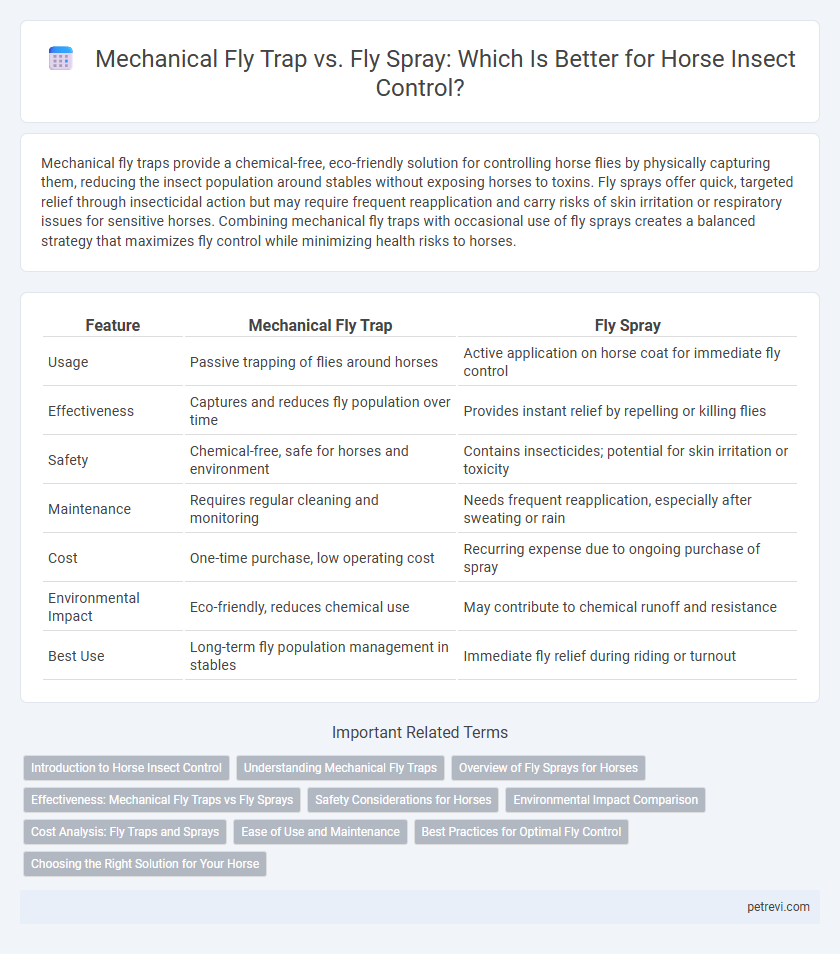Mechanical fly traps provide a chemical-free, eco-friendly solution for controlling horse flies by physically capturing them, reducing the insect population around stables without exposing horses to toxins. Fly sprays offer quick, targeted relief through insecticidal action but may require frequent reapplication and carry risks of skin irritation or respiratory issues for sensitive horses. Combining mechanical fly traps with occasional use of fly sprays creates a balanced strategy that maximizes fly control while minimizing health risks to horses.
Table of Comparison
| Feature | Mechanical Fly Trap | Fly Spray |
|---|---|---|
| Usage | Passive trapping of flies around horses | Active application on horse coat for immediate fly control |
| Effectiveness | Captures and reduces fly population over time | Provides instant relief by repelling or killing flies |
| Safety | Chemical-free, safe for horses and environment | Contains insecticides; potential for skin irritation or toxicity |
| Maintenance | Requires regular cleaning and monitoring | Needs frequent reapplication, especially after sweating or rain |
| Cost | One-time purchase, low operating cost | Recurring expense due to ongoing purchase of spray |
| Environmental Impact | Eco-friendly, reduces chemical use | May contribute to chemical runoff and resistance |
| Best Use | Long-term fly population management in stables | Immediate fly relief during riding or turnout |
Introduction to Horse Insect Control
Effective horse insect control is essential for equine health and comfort, targeting common pests like flies, mosquitoes, and stable flies that cause irritation and transmit diseases. Mechanical fly traps offer a chemical-free solution by attracting and capturing insects using light, heat, or bait, reducing fly populations over time. Fly sprays provide immediate insect repellency and insecticidal action but require frequent application and may contain chemicals that need careful handling around horses.
Understanding Mechanical Fly Traps
Mechanical fly traps offer an eco-friendly solution for horse insect control by capturing flies without the use of harmful chemicals. These traps use visual cues and attractants to lure flies into a containment area where they cannot escape, reducing fly populations effectively in stable environments. Their strategic placement around horse facilities can significantly decrease fly annoyance and the risk of disease transmission among equine populations.
Overview of Fly Sprays for Horses
Fly sprays for horses provide a targeted solution for insect control, combining active ingredients like permethrin or pyrethrin to repel and kill flies effectively. These sprays create a protective barrier on the horse's coat, reducing irritation and the risk of fly-borne diseases. Frequent application is necessary to maintain efficacy, especially in high-fly environments during warm seasons.
Effectiveness: Mechanical Fly Traps vs Fly Sprays
Mechanical fly traps provide continuous, chemical-free insect control by physically capturing flies, making them effective in reducing fly populations around horses without risk of irritation. Fly sprays offer immediate, targeted relief by repelling or killing flies on contact, but their effectiveness is limited by reapplication frequency and potential skin sensitivity issues. Combining both methods enhances overall insect control by balancing long-term population suppression and instant protection for horses.
Safety Considerations for Horses
Mechanical fly traps offer a chemical-free option for horse insect control, reducing the risk of skin irritation or respiratory issues caused by toxic fly sprays. Fly sprays may contain pyrethroids or other insecticides that, while effective, pose potential hazards if ingested or applied excessively, requiring careful handling and application away from horses' eyes and mucous membranes. Ensuring proper ventilation and selecting horse-safe formulations are critical when using fly sprays to minimize adverse health effects.
Environmental Impact Comparison
Mechanical fly traps offer an eco-friendly alternative to chemical fly sprays by capturing flies without releasing harmful substances into the environment, reducing toxic runoff and air pollution. Fly sprays, while effective for immediate insect control on horses, often contain synthetic chemicals that can contaminate soil and water sources, posing risks to non-target wildlife and beneficial insects. Utilizing mechanical fly traps minimizes chemical exposure, promoting sustainable pest management practices in equine care.
Cost Analysis: Fly Traps and Sprays
Mechanical fly traps offer a one-time purchase cost ranging from $20 to $50, with minimal maintenance expenses, making them a cost-effective long-term solution for horse insect control. Fly sprays require continuous purchases, with monthly costs averaging $15 to $30 depending on brand and usage frequency, leading to higher cumulative expenses over time. Considering cost analysis, mechanical fly traps present a budget-friendly option for sustained fly management, while fly sprays incur ongoing financial commitments.
Ease of Use and Maintenance
Mechanical fly traps offer straightforward installation and minimal daily upkeep, requiring occasional emptying and cleaning, making them low-maintenance for horse owners. Fly sprays provide quick application and immediate insect control but demand frequent reapplication to remain effective and can involve handling strong chemicals. Choosing between the two depends on whether ease of continuous maintenance or rapid, targeted insect control aligns better with the horse care routine.
Best Practices for Optimal Fly Control
Mechanical fly traps for horses offer a chemical-free solution by capturing flies using visually attractive surfaces and bait, reducing fly populations without exposing animals to pesticides. Fly sprays provide targeted, immediate relief by using insecticides formulated to repel or kill flies on contact, but require careful application to avoid skin irritation and ensure safety. Integrating mechanical traps with routine strategic fly spray use maximizes insect control efficacy while minimizing chemical resistance and environmental impact.
Choosing the Right Solution for Your Horse
Mechanical fly traps provide a non-toxic, eco-friendly way to reduce fly populations around horses by capturing flies without chemicals, making them ideal for sensitive horses prone to allergic reactions. Fly sprays offer fast-acting, broad-spectrum insect control but require careful selection to avoid skin irritation and ensure effectiveness against specific fly species like stable flies and horseflies. Evaluating factors such as horse behavior, sensitivity, environmental impact, and fly species prevalence helps determine whether mechanical traps or fly sprays best suit each horse's insect control needs.
Mechanical Fly Trap vs Fly Spray for Horse Insect Control Infographic

 petrevi.com
petrevi.com